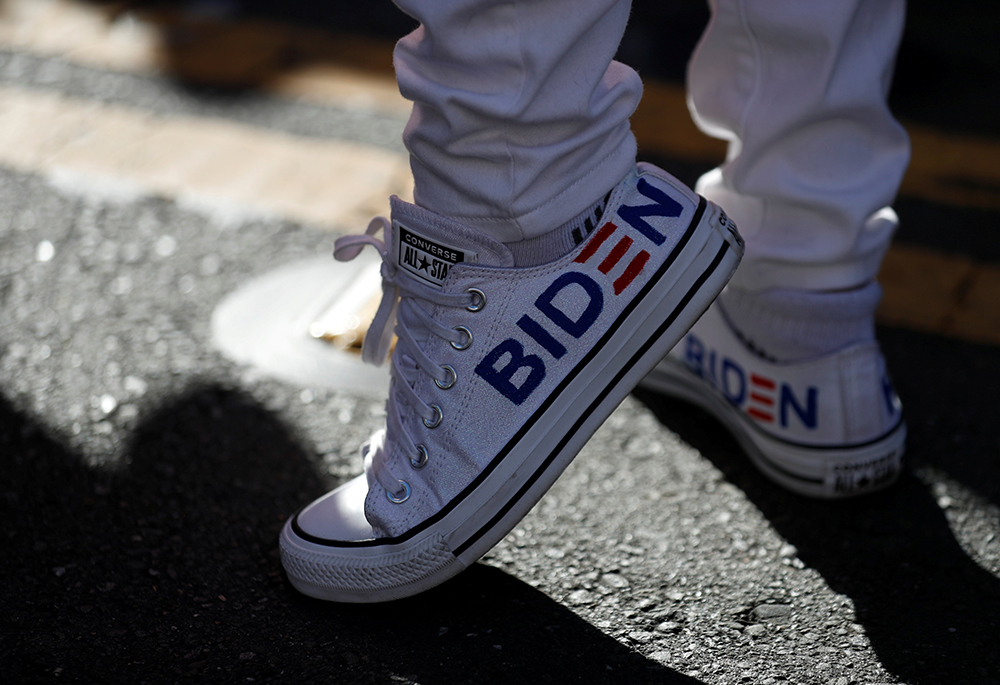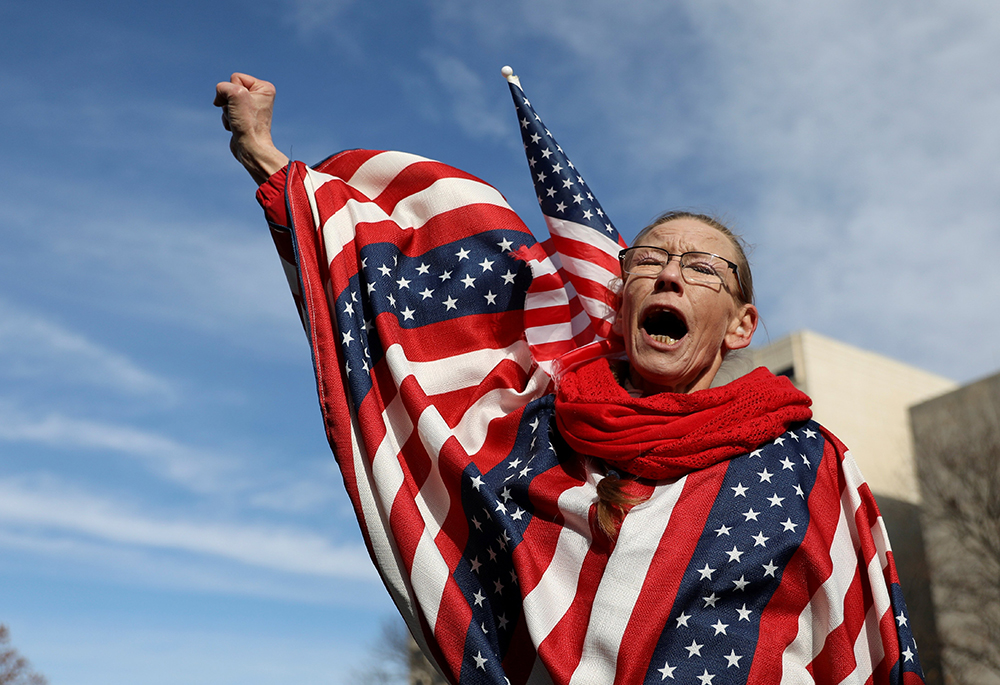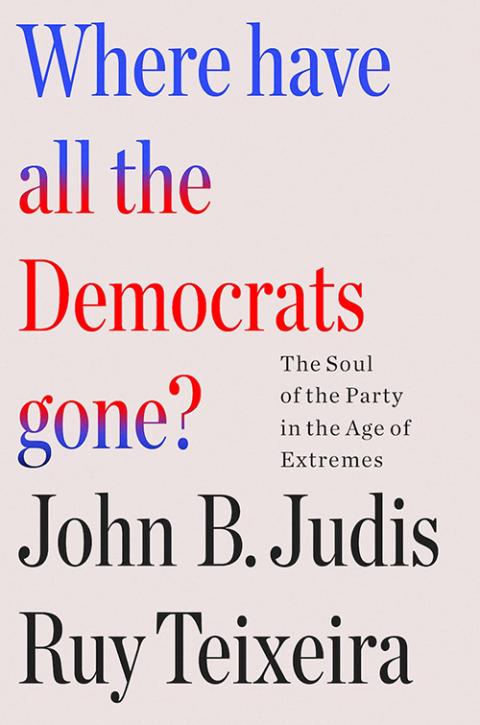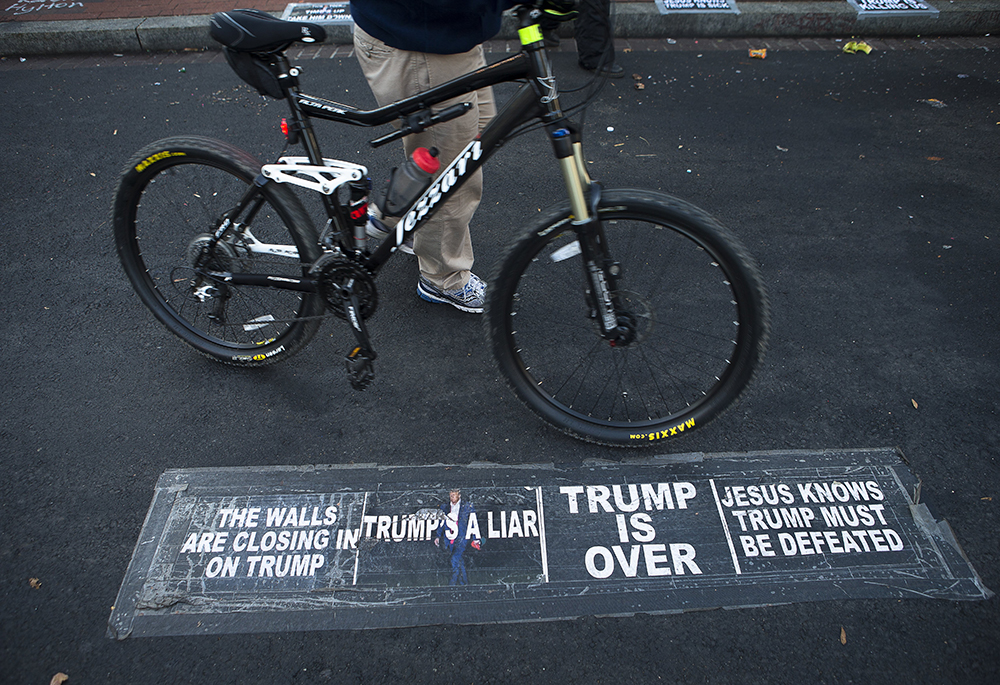
A Joe Biden supporter in San Francisco wears sneakers with his name on them Nov. 7, 2020, after news media declared the Democrat the winner of the presidential election. (CNS/Reuters/Stephen Lam)
If there is one book all the senior members of President Joe Biden's reelection campaign should read it is John B. Judis' and Ruy Teixeira's brutal and brilliant Where Have All the Democrats Gone? The Soul of the Party in the Age of Extremes. The book looks at how the party of the working class gradually alienated itself from its own base, with disastrous consequences for its electoral viability and, with the rise of Trumpian illiberalism, disastrous consequences for the country.
Judis and Teixeira collaborated on a previous book, The Emerging Democratic Majority, published in 2002. It argued that the demographics of the electorate pointed to Democratic dominance in the years ahead as the nation's fastest growing areas were precisely those urban polities with cosmopolitan values and increasing numbers of Latino voters and young people keen to protect the environment were inclined to support the Democrats. Barack Obama's victory in the 2008 presidential contest seemed to vindicate their thesis.
Then came 2016.
Judis and Teixeira were not entirely wrong: younger voters, unmarried women, Latinos and other minorities do continue to lean decidedly towards the Democrats, especially those who have gone to college. What they admit they did not foresee is the degree to which the Democrats would hemorrhage white, working-class voters in the nation's heartland, and the growth of a now seemingly unbridgeable divide between the two parties.

A supporter of President Donald Trump participates in a "Stop the Steal" protest in Lansing, Michigan, Nov. 14, 2020, after the presidential election was called by the media for Democrat Joe Biden a week earlier. (CNS/Reuters/Emily Elconin)
"On one side of the divide are the great postindustrial metro centers like the Bay Area, Atlanta, Austin, Los Angeles, Chicago, Boston, New York and Seattle," they write. In these areas, education is critical to economic success, real estate values have ballooned, the culture is international and chic, and social values are libertarian. Voters are susceptible to the moral and intellectual vanities that attend elite status.
"On the other side of the divide are the small towns and midsize cities that have depended on manufacturing, mining and farming." Most of these areas have never recovered from the factory closings of the 1970s and later, with high unemployment and vanishing social capital. For them, the appeal to "Make America Great Again" has a genuine resonance, even if it is peddled by a charlatan. These towns were once vibrant communities with good paying jobs and now the only growth industry is opioids. Parents could raise their children to do better than they had, but no longer. The churches and the Elks and the Kiwanis were active and no one yet had to go bowling alone. Their social values were and are conservative. With the decline of social capital in their communities, the voters are exploitable by demagogues.
The Democrats once were the party of the working class, but that began to fade in the 1960s with the rise of the "New Left" and the decline of organized labor. In fact, the decline of labor's influence is one of the key political dynamics in this tale. "In 1965, when unions had filed petitions with the National Labor Relations Board to be recognized as collective bargaining agents, 42 percent of companies immediately complied," the authors note. "By 1973, only 16 percent did."
Advertisement
Big business was fighting back and fighting effectively. In addition to resisting organizing efforts in their companies, they began major lobbying operations in D.C. When President Jimmy Carter tried to enact a series of progressive economic policies, such as raising taxes on capital gains and increasing penalties on companies that illegally fought union organizing efforts, he and the Democrats "proved no match for the newly forged K Street constellation of business groups, think tanks, and policy groups. The business lobbies, with full Republican support, were able to defeat or even reverse Carter and the Democrats' proposals," the authors write. Carter's decision to nominate Paul Volcker to become chairman of the Federal Reserve highlighted the Democrats' increasing dependence on the economic advice of Wall Street partisans.
Labor's loss of influence created a vacuum into which issue-oriented groups like the National Association for the Repeal of Abortion Laws, People for the American Way and Friends of the Earth were only too happy to move. The authors note that the "groups' staffs and their prime constituencies were the college-educated voters who lived in the big metro centers. They were cut off socially and politically from much of the electorate, and in particular from what had been the Democratic Party's older working-class base. Many of these working-class voters rejected the groups' views on abortion, the death penalty, gun control, environmental protection (which was seen as a threat to jobs), and affirmative action."

Book cover to Where Have All the Democrats Gone?
The chapter on "The Successes and Failures of the New Democrats" continues the tale of the gradual alienation of the Democratic Party from the concerns and interests of working-class voters. Bill Clinton campaigned on promises of economic populism, but he abandoned the policies that would have enfleshed those promises. While people armed with MBAs saw free trade pacts like NAFTA as part of the inexorable victory of capitalism, working-class folk saw their jobs depart when the factories closed. Rubbing salt into the wound, Clinton bowed to the economic advice of Wall Street advisers like Robert Rubin and refused to eliminate the tax deduction for executive salaries over a million dollars, as he had promised to do. Performance bonuses for upper management became tax deductible too. In Silicon Valley and on Wall Street, "ballooning wealth" and the financialization of the economy was the result.
There was another result to the Democrats adopting a laissez-faire approach to economic issues, just like the Republicans: The economic crash of 2008. The unbridled confidence in the markets ended with a contagion of fiscal malpractice and fear on Wall Street and the greatest economic collapse since the Great Depression. Even Alan Greenspan, chairman of the Federal Reserve and longtime exponent of the belief that markets were self-regulating, had to admit he'd been wrong about that. The economic meltdown also helped propel Obama into the presidency.
Obama followed the Clintonian script: Establish your centrist bona fides on economic issues, not social ones. He came to the rescue of the banks that had caused the crisis, but homeowners were left to fend for themselves. He managed to enact the Affordable Care Act, but the law was too clever by half in some respects. Many of the benefits were delayed to save money. Republican opponents painted the new medical system as a big government handout to poor people.
Most of all, Democrats failed to defend the law and Obama himself failed to see that his governing maxim — good policy is good politics — would only prove true in the long term. In the 2010 midterm elections, the Democrats lost 63 seats in the House, 6 seats in the Senate, 6 governorships and a stunning 25 state legislative chambers. These latter would play a critical role in redistricting, allowing the GOP to entrench many of their gains.

A man walks on Black Lives Matter Plaza near the White House in Washington Nov. 8, 2020, one day after the media declared Democrat Joe Biden had won the presidential election. (CNS/Tyler Orsburn)
Obama was lucky to draw a plutocrat and investment banker, Mitt Romney, as an opponent in 2012, permitting Obama to pose as the populist in the race. The president doubled down on abortion rights in his reelection campaign and now openly backed same-sex marriage. Obama would remain personally popular throughout his eight years in the White House, but he "left the Democratic electoral coalition in a shambles. … Republicans controlled 32 governorships and Democrats only 17. Republicans controlled both houses of 30 state legislatures and Democrats only 11," Judis and Teixeira note.
Then came 2016. When Hillary Clinton called many of Trump's supporters "deplorables," she said the quiet part out loud, confirming the suspicions of millions of working-class voters that the Democrats not only failed to look out for their interests, but looked down on them personally. Working-class voters "have been thrown back on the most basic elements of their identities: nation, family, and faith, the cars they drive, or the guns they own, which protect the home and family. … They feel threatened, and looked down upon, by the upscale denizens of the postindustrial cities," the authors write. Trump claimed to speak for them. Clinton's numbers among white working-class voters were worse than any Democrat since 1984. When he ran for reelection in 2020, Trump made significant gains with Black and Latino working-class voters too, increasing his share by 6% and 18% respectively, according to data the authors cite.
So far, the book is an excellent analysis of the changing shape of electoral politics. Friday, we'll turn to the second half of the book which continues the fine analysis but ventures into highly controversial territory.







